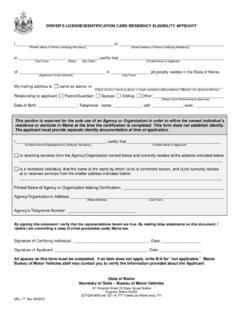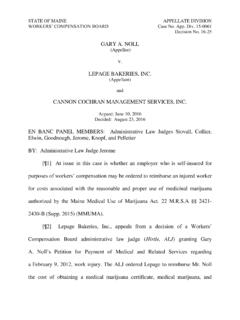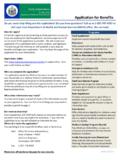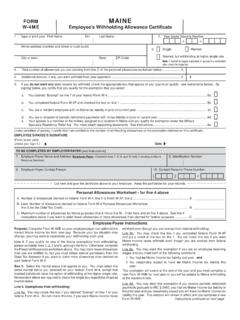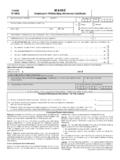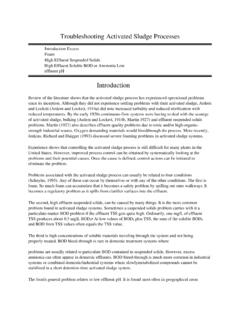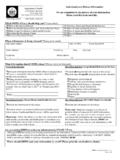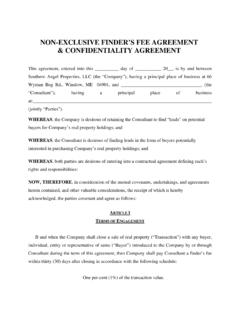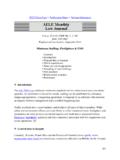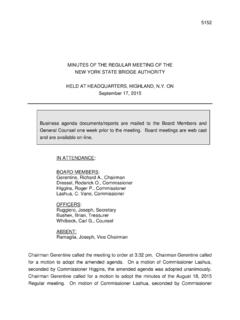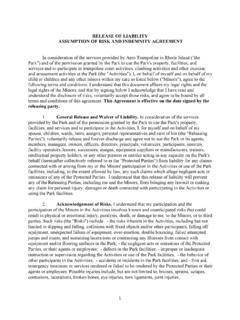Transcription of A Review of Adult Mental Health Mobile Crisis …
1 A Review of Adult Mental Health Mobile Crisis Programs Prepared for: Department of Health and Human Services Office of Adult Mental Health Services Prepared by: Cheryl LeBlond, LCSW University of Southern maine Muskie School of Public Service February 2008 Crisis Review EXECUTIVE SUMMARY INTRODUCTION The maine Mental Health Crisis Services Standards, initially developed by Crisis providers and subsequently updated by the Office of Adult Mental Health Services (OAMHS), as specified in the October 2006 Consent Decree Plan, were finalized November 30, 2006. To monitor and ensure compliance with the new standards a regularly scheduled Review will be conducted at intervals defined by the OAMHS. This initial year helped develop the content and structure of the Review by looking at a small sample from each agency. Subsequent reviews will promote greater consistency in the application of Crisis standards statewide, and help clients and family members, as well as those running Crisis programs, understand what quality services look like.
2 This report summarizes the findings of the initial Crisis reviews. The reviews provide measurable indicators of current services, highlight areas of strength, and help agencies focus their attention on areas to improve. The information evaluated by the Review team included: Policies and Procedures Manual(s); Documentation of telephone and face-to-face contacts for the last three months; Documentation of supervision, training, and licensing and/or certification for all staff; Contracts with consultants (if any); List of employees; Staffing schedules for the previous 2 weeks by shift and provider type, LCSW, MHRT/CSP, etc.; All Memoranda of Understanding with hospitals, law enforcement, etc. The Review team selected by OAMHS was comprised of: Darren Morgan, MDiv, LSW, Region III Team Leader; Naya Blue, LCSW, Office of Consumer Affairs; Katherine Storer, MSW, Office of Consumer Affairs and Cheryl LeBlond, LCSW, Independent Clinical Consultant.
3 An Adult Mental Health Crisis Standards Protocol was produced in collaboration between the University of Southern maine s Muskie School of Public Service and the maine Department of Health and Human Services (DHHS), OAMHS to be used as a standard tool in the Review process. The tool reflected the required components of the Crisis Services Standards. METHODOLOGY Eleven Adult Crisis programs were visited and reviewed between November 2007 and January 2008. The agencies reviewed were Aroostook Mental Health Center, Community Health and Counseling Services, Crisis and Counseling, Crisis Services Inc., Evergreen Behavioral Health , Ingraham, Mid-Coast Mental Health Center, Oxford Mental Health Services, Sweetser, Tri-County Mental Health Center, and Washington County Psychotherapy Associates. The reviewers randomly selected and evaluated a total of 587 single Crisis event telephone contacts. Sixty-seven single Crisis event face-to-face assessments were reviewed.
4 The reviewers focused on Crisis services that occurred within a three-month timeframe preceding the scheduled visit. In addition, the team also conducted a random chart Review of a limited number of records using a 2modified tracer methodology tracing the record from point of entry (phone contact) through assessment, stabilization and outcome recommendations and/or referrals. The tracer process focused on Crisis services that were conducted within 48 hours of the Review visit. The 33 clinical records that were reviewed using the tracer format represent a small random sample rather than a scientific sample. FINDINGS Crisis services throughout the state all operate with the same basic premise of screen, assess and assist the client to an immediate resolution. From there providers have differences in providing stabilization, intervention, and other aspects of Crisis work. The Review team found that in terms of compliance with the standards, all providers need to improve in the following areas: documentation, the use of Crisis plans, updating Memoranda of Understanding (MOU), capturing the consumer perspective, collaborating with others, and supervision.
5 In addition, findings indicate that the use of emergency departments warrants additional investigation. Documentation Telephone contacts appeared to have the least documentation and often did not meet all of the components outlined in the Crisis Standards. Most commonly missing from the telephone clinical notes were risk factors, the specific intervention used, and the evaluation of the intervention. Descriptions of the presenting problems were recorded 100% for 10 agencies and 95% for one agency. The style in which clinical notes were written often did not capture the perspective of the consumer. Often an added sentence or two could provide context for the complete Crisis intervention that has occurred and provide additional insight into the quality of service being provided. Notes that contained direct quotes from the client appeared to best reflect the consumer perspective. Some providers had adapted a good practice of asking the client s wishes and documenting the desired outcome.
6 In cases where the wishes and outcome did not match, an explanation for the inconsistency was recorded. In all cases where a documented disconnect occurred, the reason for a different outcome was clinically indicated. Crisis Plans The Review team examined face-to-face documentation to determine whether it included a Crisis plan, whether an existing Crisis plan was utilized during the Crisis contact, and whether a Crisis plan that was developed was shared with other providers. Crisis plans were not consistently used. Only one team asked 100% of the time if a Crisis plan existed. Another six teams asked an average of 45% of the time. Seven of 11 teams did not utilize the Crisis plan during the Crisis contact. Of the four teams that used a Crisis plan, only 28% shared the plan with providers. The majority of teams stated that they do not refer to Crisis plans. The common reason for not screening for Crisis plans is because the opportune time for implementing the Crisis plan has passed when the client is calling or seeing the Crisis provider; by then, the person is experiencing a higher level of acuity.
7 3 Memoranda of Understanding The content of the MOUs widely varied. Ten of 11 teams had existing MOUs for hospitals and all consistently included sharing of information and clear channels of communication. The majority of the MOUs address liability issues and do not identify the expectations of each entity. The Rapid Response Protocol and performance goals that are outlined in the standards were also consistently missing from the MOUs. Six teams complied with the standard requiring law enforcement MOUs. Many MOUs have not been updated to reflect the current components listed in the standards. Some MOUs were automatically renewed and, therefore, had not been reviewed in years. In addition to the standard that requires a quarterly meeting to discuss issues of concern, an annual meeting may be arranged to ensure that all participants are still in agreement. Clinical Forms The Review team recognized a connection between a provider s assessment forms and the quality of the Crisis assessment.
8 Forms that asked specific questions from the Crisis standards were in greater compliance than those that relied on clinicians to remember questions. Sections of the forms appeared to be completed to the level required by DHHS licensing. Clinically, forms were often lacking contextual detail. Among the forms reviewed, the most effective form was designed to assume that the Crisis standards were being met unless otherwise documented; it also incorporated many quotes from clients. This format appeared to represent a level of quality and professionalism. MHRT/CSP The new Mental Health Rehabilitation Technician/ Crisis Services Provider (MHRT/CSP) certification was implemented April 2007. Agencies were given until April 2008 to fully credential tenured Crisis staff. New staff hired after April 1, 2007 were expected to be fully credentialed prior to working independently, as cited in the MHRT/CSP Certification Requirements. Many of the Crisis providers are currently conducting the Crisis curriculum training.
9 Data collected during the Review process provide a snapshot of MHRT/CSP implementation. At the time of this Review , approximately 25% of the 278 Crisis staff identified by the maine Crisis Services Network had already received their MHRT/CSP. Since April 1, 2007, 63% of new staff hired were MHRT/CSP certified. Quality Service Solid documentation appeared to be the key to gaining insight into quality service. In cases where documentation was minimal, Review team members asked follow up questions to the staff to help complete the whole story and the unfolding of events. Consumers and Crisis constituents were not interviewed during this process. In most cases the actual practice was consistent with quality service, although the documentation was unclear. Quality service includes documentation that is clear, thorough and concise. Effective documentation includes the consumer s perspective, the lowest level of clinically indicated intervention, efforts to connect clients to natural and professional supports, assisting in referrals to appropriate services that address ongoing needs, and providing immediate intervention that includes an interim plan to help resolve the current Crisis .
10 In addition, quality service was observed through notes that recorded reasons for missing information or an intervention that was inconsistent with the presenting problem or diagnosis. Through this style of documentation, it was clear that questions were being asked and certain considerations had occurred, which created thorough clinical notes without being verbose. The majority of Crisis staff practiced what was in the agencies written policies and procedures. In situations where practice did not comply with the Crisis standards, reviewers often found that the 4agency did not have a policy or procedure to reflect the standard. A few Crisis programs wrote their procedures according to the Crisis standards. This appeared to make it easier for providers to monitor adherence to the standards. Supervision Seven of the 11 Crisis programs meet the Crisis standard for supervision. However, the majority of Crisis providers inquired about a best practice to fulfill the face-to-face supervision requirements.
